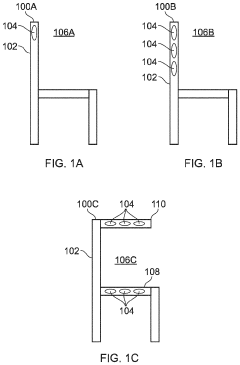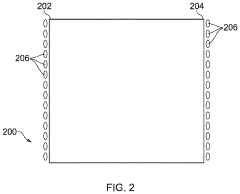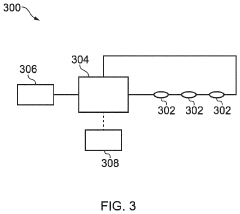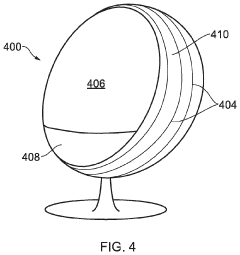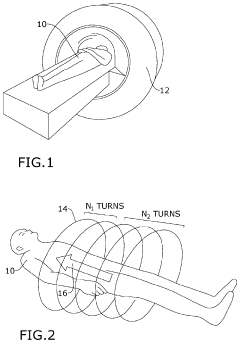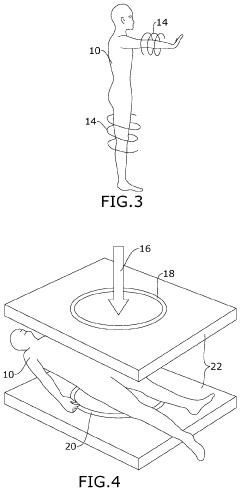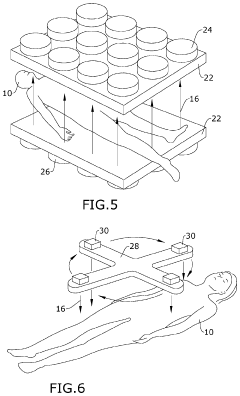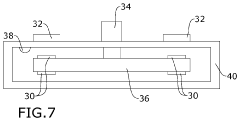Investigating Schumann Resonance in Earth Sciences
Schumann Resonance Background and Objectives
Schumann resonances, first predicted by physicist Winfried Otto Schumann in 1952, are a set of spectrum peaks in the extremely low frequency (ELF) portion of the Earth's electromagnetic field spectrum. These resonances occur between the Earth's surface and the ionosphere, creating a natural global electromagnetic resonance phenomenon. The primary frequency of Schumann resonances is approximately 7.83 Hz, with subsequent harmonics at higher frequencies.
The study of Schumann resonances has gained significant attention in Earth sciences due to its potential applications in various fields, including atmospheric science, climate research, and geophysics. These resonances provide valuable insights into the Earth-ionosphere cavity and its interactions with solar activity, lightning discharges, and other geophysical phenomena.
The primary objective of investigating Schumann resonances in Earth sciences is to enhance our understanding of the Earth's electromagnetic environment and its relationship with various geophysical processes. This research aims to develop more accurate models of the Earth-ionosphere system, improve global lightning detection techniques, and explore potential correlations between Schumann resonances and climate change.
One of the key goals is to utilize Schumann resonances as a tool for monitoring global lightning activity. By analyzing the variations in resonance frequencies and amplitudes, researchers can gain valuable information about the distribution and intensity of lightning strikes across the planet. This data can contribute to improved weather forecasting models and enhance our understanding of severe weather patterns.
Another important objective is to investigate the potential links between Schumann resonances and ionospheric dynamics. Changes in the ionosphere's composition and structure can affect the characteristics of Schumann resonances, making them a potential indicator of ionospheric disturbances caused by solar activity or other geophysical events.
Furthermore, researchers aim to explore the possible connections between Schumann resonances and human health. Some studies suggest that these natural electromagnetic frequencies may have biological effects, potentially influencing circadian rhythms and other physiological processes. While this area remains controversial, it represents an intriguing avenue for interdisciplinary research.
As technology advances, the development of more sensitive and accurate measurement techniques for Schumann resonances is a crucial objective. Improved instrumentation and data analysis methods will enable researchers to detect subtle variations in resonance parameters, leading to more precise observations and a deeper understanding of the Earth's electromagnetic environment.
Earth Science Applications and Market Demand
Schumann resonance, a natural electromagnetic phenomenon occurring in the Earth's ionosphere, has gained significant attention in Earth sciences due to its potential applications and market demand. This low-frequency electromagnetic oscillation, typically around 7.83 Hz, offers valuable insights into various geophysical processes and environmental conditions.
In the field of atmospheric science, Schumann resonance measurements provide a unique tool for monitoring global lightning activity and thunderstorm distributions. This information is crucial for understanding climate patterns and weather systems, making it highly valuable for meteorological agencies and climate research institutions. The ability to detect and analyze Schumann resonances has led to the development of specialized equipment and software, creating a niche market for scientific instrumentation companies.
Geophysicists and seismologists have also shown interest in Schumann resonance as a potential indicator of seismic activity. Some studies suggest that variations in Schumann resonance parameters may correlate with earthquake precursors, although this relationship remains a subject of ongoing research. This potential application has sparked interest from government agencies and private companies involved in earthquake prediction and risk assessment.
The environmental monitoring sector represents another significant market for Schumann resonance applications. As a global phenomenon, Schumann resonance can be used to assess the overall state of the Earth's electromagnetic environment. This capability is particularly relevant in studying the effects of solar activity on the Earth's ionosphere and potential impacts on communication systems and power grids.
In recent years, there has been a growing interest in the potential biological effects of Schumann resonance. Some researchers hypothesize that this natural electromagnetic frequency may influence human health and circadian rhythms. This has led to a burgeoning market for wellness products and therapies claiming to replicate or harness Schumann resonance, although the scientific basis for these claims remains controversial.
The space weather community has also recognized the value of Schumann resonance measurements in monitoring ionospheric conditions and solar-terrestrial interactions. Space agencies and satellite operators are increasingly interested in incorporating Schumann resonance data into their space weather prediction models to enhance the protection of space-based assets and communication systems.
As awareness of Schumann resonance grows, there is an expanding market for educational tools and resources related to this phenomenon. Universities, schools, and science museums are seeking materials and equipment to demonstrate and teach about Schumann resonance, creating opportunities for educational technology providers and scientific equipment manufacturers.
Current State and Challenges in SR Detection
Schumann Resonance (SR) detection has made significant strides in recent years, yet it continues to face several challenges. The current state of SR detection is characterized by a mix of advanced technologies and persistent limitations. Modern SR detection systems typically employ highly sensitive magnetometers, such as Superconducting Quantum Interference Devices (SQUIDs) or induction coil magnetometers, to measure the extremely weak magnetic field fluctuations associated with SR.
One of the primary challenges in SR detection is the low signal-to-noise ratio. The SR signal is extremely weak, often masked by various sources of electromagnetic noise, including human-made interference and natural phenomena like lightning strikes. This necessitates sophisticated signal processing techniques and careful site selection for SR monitoring stations, typically in remote locations far from urban areas and industrial activities.
Another significant challenge is the need for long-term, continuous monitoring to capture the full spectrum of SR variations. This requires robust, stable instrumentation capable of operating reliably for extended periods in often harsh environmental conditions. Maintaining the calibration and consistency of these instruments over time presents ongoing technical challenges.
The global nature of SR phenomena also poses challenges for comprehensive detection and analysis. While there are several SR monitoring stations worldwide, achieving a truly global coverage remains difficult due to geographical and logistical constraints. This limitation affects our ability to fully understand the global patterns and variations in SR.
Data processing and interpretation present additional challenges. The complex nature of SR signals, influenced by various geophysical and atmospheric factors, requires sophisticated algorithms and models for accurate analysis. Developing and refining these analytical tools is an ongoing area of research in the field.
Recent advancements in SR detection include the development of more sensitive and stable magnetometers, improved signal processing algorithms, and the integration of SR measurements with other geophysical and atmospheric data. These improvements have enhanced our ability to extract meaningful information from SR signals and correlate them with various Earth system processes.
However, challenges remain in distinguishing between different sources of SR variations, such as those caused by solar activity, atmospheric dynamics, or changes in the Earth's ionosphere. Improving this discrimination is crucial for leveraging SR data in various Earth science applications, including climate monitoring, earthquake prediction, and space weather forecasting.
As research in this field progresses, there is a growing focus on developing more compact, cost-effective SR detection systems. This could potentially lead to a denser global network of SR monitoring stations, improving our ability to study these resonances on a truly global scale. Additionally, efforts are underway to integrate SR detection with other Earth observation technologies, creating a more comprehensive picture of the Earth's electromagnetic environment.
Existing SR Detection and Analysis Methods
01 Schumann resonance devices for health and wellness
Various devices are designed to generate or utilize Schumann resonance frequencies for potential health benefits. These devices aim to simulate the natural electromagnetic frequencies of the Earth to promote relaxation, improve sleep quality, and enhance overall well-being. Some implementations include wearable devices, room-based generators, and portable units that can be used in different environments.- Schumann resonance devices for health and wellness: Various devices are designed to generate or utilize Schumann resonance frequencies for potential health benefits. These devices aim to simulate the natural electromagnetic frequencies of the Earth to promote relaxation, improve sleep quality, and enhance overall well-being. Some implementations include wearable devices, room-based generators, and portable units that emit Schumann resonance frequencies.
- Integration of Schumann resonance in therapeutic applications: Schumann resonance is incorporated into various therapeutic applications and medical devices. These applications may include stress reduction, pain management, and improving cognitive function. Some devices combine Schumann resonance with other therapies such as light therapy, sound therapy, or magnetic field therapy to enhance their effectiveness.
- Schumann resonance measurement and monitoring systems: Systems and methods are developed for measuring and monitoring Schumann resonance frequencies in the environment. These systems may be used for scientific research, environmental monitoring, or as part of health and wellness applications. Some implementations include portable devices for personal use or larger systems for continuous monitoring in specific locations.
- Schumann resonance generators for agricultural applications: Schumann resonance generators are designed for use in agricultural settings to potentially improve crop growth and soil health. These devices aim to simulate natural electromagnetic conditions that may benefit plant growth, seed germination, and overall crop yield. Some implementations include portable units for small-scale farming or larger systems for industrial agriculture.
- Schumann resonance shielding and protection devices: Various devices and methods are developed to shield or protect individuals from excessive electromagnetic frequencies while maintaining beneficial Schumann resonance exposure. These may include specialized clothing, room shielding materials, or personal protective devices that filter out harmful frequencies while allowing Schumann resonance to pass through.
02 Schumann resonance in electromagnetic shielding
Electromagnetic shielding systems incorporate Schumann resonance frequencies to create a more natural electromagnetic environment. These systems are designed to protect against harmful electromagnetic radiation while maintaining beneficial Earth-like frequencies. Applications include shielding for buildings, vehicles, and personal protective equipment.Expand Specific Solutions03 Schumann resonance in water treatment and agriculture
Schumann resonance frequencies are applied in water treatment processes and agricultural practices. These applications aim to improve water quality, enhance plant growth, and increase crop yields by exposing water or plants to specific electromagnetic frequencies that mimic the Earth's natural resonance.Expand Specific Solutions04 Schumann resonance measurement and monitoring devices
Specialized equipment is developed for measuring and monitoring Schumann resonance frequencies in various environments. These devices are used for scientific research, environmental monitoring, and potential applications in predicting natural phenomena such as earthquakes or severe weather events.Expand Specific Solutions05 Schumann resonance in energy harvesting and wireless communication
Innovative technologies harness Schumann resonance frequencies for energy harvesting and wireless communication applications. These systems aim to utilize the Earth's natural electromagnetic field as a power source or communication medium, potentially enabling long-range, low-power wireless devices and energy-efficient systems.Expand Specific Solutions
Key Players in SR Research and Instrumentation
The investigation of Schumann Resonance in Earth Sciences is currently in a growth phase, with increasing market size and technological advancements. The competitive landscape is diverse, featuring both established players and emerging companies. Key industry leaders like Schlumberger, Landmark Graphics, and PGS Geophysical are driving innovation in this field. The technology's maturity is progressing, with companies such as BP Corporation North America, ExxonMobil Upstream Research, and Shell Internationale Research Maatschappij BV investing in research and development. Academic institutions like the University of Bern and Jilin University are also contributing to the advancement of Schumann Resonance applications, indicating a collaborative approach between industry and academia in this evolving sector.
University of Bern
Jilin University
Core Innovations in SR Signal Processing
- A magnetic field exposure system generating an amplitude-modulated low frequency magnetic field with a carrier frequency of 360 to 450 Hz and a modulation frequency of 0.5 to 100 Hz, providing a field strength of 0.5 to 250 μT, specifically designed to enhance cell survival, proliferation, reduce stress, and promote tissue regeneration.
- Applying static or alternating magnetic fields with intensities significantly higher than natural Earth fields, using devices like MRI, permanent magnets, and solenoids to disrupt viral metabolism by altering the structure and function of viral particles and host cells.
Global SR Monitoring Network Development
The development of a Global Schumann Resonance (SR) Monitoring Network represents a significant advancement in Earth sciences research. This network aims to establish a comprehensive system of SR monitoring stations across the globe, enabling scientists to collect and analyze data on a planetary scale.
The primary objective of this network is to create a standardized infrastructure for SR measurements, ensuring consistent data collection and analysis methodologies across different geographical locations. This standardization is crucial for comparing and correlating SR data from various parts of the world, leading to more accurate and reliable scientific insights.
One of the key components of the Global SR Monitoring Network is the deployment of highly sensitive electromagnetic sensors. These sensors are designed to detect the extremely low-frequency electromagnetic waves that constitute Schumann Resonances. The network utilizes a combination of magnetic field sensors, such as induction coils or SQUID magnetometers, and electric field sensors to capture the full spectrum of SR phenomena.
Data acquisition systems play a vital role in the network's functionality. These systems are responsible for digitizing and storing the raw SR signals, often employing high-resolution analog-to-digital converters to capture the subtle variations in the electromagnetic field. Advanced signal processing techniques are then applied to extract meaningful information from the raw data, including frequency analysis, spectral decomposition, and noise reduction algorithms.
The Global SR Monitoring Network also incorporates a robust data transmission and storage infrastructure. Real-time data streaming capabilities allow for immediate access to SR measurements from remote locations, facilitating rapid analysis and response to unusual events. Cloud-based storage solutions are often employed to manage the vast amounts of data generated by the network, ensuring data integrity and accessibility for researchers worldwide.
Collaboration between international research institutions is a cornerstone of the Global SR Monitoring Network. This cooperation involves sharing resources, expertise, and data, fostering a global community of scientists dedicated to SR research. The network also promotes the development of open-source software tools for data analysis and visualization, encouraging transparency and reproducibility in scientific findings.
As the network expands, efforts are being made to integrate SR monitoring with other Earth observation systems. This integration allows for correlative studies between SR phenomena and various geophysical and atmospheric processes, enhancing our understanding of the Earth's electromagnetic environment and its interactions with other planetary systems.
SR Applications in Climate Change Studies
Schumann Resonance (SR) has emerged as a valuable tool in climate change studies, offering unique insights into global atmospheric dynamics. As Earth's climate continues to evolve, researchers are increasingly turning to SR measurements to detect and analyze long-term trends in atmospheric conditions.
One of the primary applications of SR in climate change research is the monitoring of global temperature variations. SR frequencies are sensitive to changes in the Earth-ionosphere cavity, which can be influenced by temperature fluctuations. By analyzing long-term SR data sets, scientists can identify subtle shifts in global temperature patterns, complementing traditional temperature measurement methods.
SR measurements also provide valuable information about the frequency and intensity of lightning activity worldwide. As climate change alters precipitation patterns and atmospheric moisture content, changes in lightning occurrence can be detected through SR observations. This data helps researchers understand the complex relationships between climate change, severe weather events, and atmospheric electricity.
Furthermore, SR has proven useful in studying the effects of solar activity on Earth's climate. The ionosphere, which forms the upper boundary of the Earth-ionosphere cavity, is influenced by solar radiation and particle emissions. By correlating SR data with solar activity indices, scientists can investigate the sun's role in climate variability and long-term climate trends.
SR applications extend to the study of atmospheric aerosols and their impact on climate. Changes in aerosol concentrations, whether from natural sources or human activities, can affect the electrical properties of the atmosphere. SR measurements can detect these changes, providing insights into the complex interactions between aerosols, cloud formation, and climate forcing.
In recent years, SR has been employed to investigate potential links between climate change and extreme weather events. By analyzing SR data during periods of intense storms, heatwaves, or other extreme phenomena, researchers aim to identify patterns that may indicate climate change-induced alterations in atmospheric behavior.
The global nature of SR measurements makes them particularly valuable for studying large-scale climate phenomena such as El Niño and La Niña events. These oscillations in ocean temperatures and atmospheric circulation patterns can have far-reaching effects on global climate, and SR data can help track their development and impact on a planetary scale.
As climate change continues to pose significant challenges, the integration of SR measurements with other climate monitoring techniques offers a more comprehensive understanding of Earth's changing atmosphere. This multifaceted approach enhances our ability to detect, analyze, and potentially mitigate the impacts of climate change on our planet.
